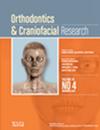The short- and long-term effects of congenital occlusion loss of the unilateral first permanent molar on the temporomandibular joint morphology and position: A retrospective study based on cone-beam computed tomography
Abstract
Objective
To investigate the effects of congenital unilateral first permanent molar occlusal loss (CUMOL) on the morphology and position of temporomandibular joint (TMJ).
Materials and Methods
Cone-beam computed tomography (CBCT) images of 37 patients with CUMOL (18 males and 19 females, mean age: 13.60 ± 4.38 years) were divided into two subgroups according to the status of second molar (G1: the second molar not erupted, n = 18, G2: second molar erupted, n = 19). The control group consisted of 33 normal occlusion patients (9 males and 24 females, mean age: 16.15 ± 5.44 years) and was divided into 2 subgroups accordingly (G3: the second molar had not erupted, n = 18, G4: the second molar had erupted and made contact with the opposing tooth, n = 15). Linear and angular measurements were used to determine the characteristics of TMJ.
Results
In G1, the condyle on the side of the CUMOL shifts posteriorly, with significant side differences observed in Anterior space (AS, P < .05) and Posterior space (PS, P < .05). However, with the eruption of the second permanent molars, in G2, the condyle on the CUMOL side moves posteriorly and inferiorly. This results in significant lateral differences in the AS (P < .05), PS (P < .05), and Superior space (SS, P < .05). Additionally, there is an increase in the thickness of the roof of the glenoid fossa (TRF) on the CUMOL side (P < .05), and a decrease in the inclination of the bilateral articular eminences (P < .05).
Conclusions
CUMOL can affect the position and the morphology of the condyle and was associated with the eruption of the second permanent molars. Before the eruption of the second permanent molars, CUMOL primarily affects the position of the condyle. After the emergence of the second permanent molars, CUMOL leads to changes in both the condyle's position and the morphology of the glenoid fossa.

 求助内容:
求助内容: 应助结果提醒方式:
应助结果提醒方式:


